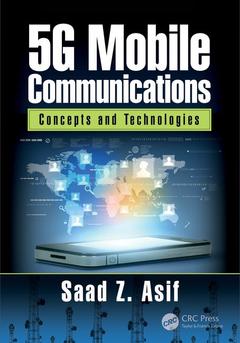5G Mobile Communications Concepts and Technologies
Auteur : Asif Saad

This book will help readers comprehend technical and policy elements of telecommunication particularly in the context of 5G. It first presents an overview of the current research and standardization practices and lays down the global frequency spectrum allocation process. It further lists solutions to accommodate 5G spectrum requirements.
The readers will find a considerable amount of information on 4G (LTE-Advanced), LTE-Advance Pro, 5G NR (New Radio); transport network technologies, 5G NGC (Next Generation Core), OSS (Operations Support Systems), network deployment and end-to-end 5G network architecture.
Some details on multiple network elements (end products) such as 5G base station/small cells and the role of semiconductors in telecommunication are also provided. Keeping trends in mind, service delivery mechanisms along with state-of-the-art services such as MFS (mobile financial services), mHealth (mobile health) and IoT (Internet-of-Things) are covered at length. At the end, telecom sector?s burning challenges and best practices are explained which may be looked into for today?s and tomorrow?s networks.
The book concludes with certain high level suggestions for the growth of telecommunication, particularly on the importance of basic research, departure from ten-year evolution cycle and having a 20?30 year plan.
- Explains the conceivable six phases of mobile telecommunication?s ecosystem that includes R&D, standardization, product/network/device & application development, and burning challenges and best practices
- Provides an overview of research and standardization on 5G
- Discusses solutions to address 5G spectrum requirements while describing the global frequency spectrum allocation process
- Presents various case studies and policies
- Provides details on multiple network elements and the role of semiconductors in telecommunication
- Presents service delivery mechanisms with special focus on IoT
Chapter 1 The Beginning. Mobile Cellular Telephony Evolution. Hexagon Based Mobile Cellular Telephony. Manuscript Overview. Section I. Chapter 2 Research and Technology Development. Basic versus Applied Research. R&D in ICT. Strengthening the ICT R&D Ecosystem. Chapter 3 Radio Frequency Spectrum. Radio Spectrum and Mobile Communications. Frequency Allocation and Identification. Frequency Spectrum Needs of 5G. Section II. Chapter 4 Standardization. Key SDOs and their Standardization Processes. 5G Standardization. ITU-T Guidelines for Establishing SDOs in Developing Nations. Case Study—Lack of Research and Standardization in OIC Member States. Chapter 5 5G Concepts. 5G Objectives and Usage Scenarios. 5G Activities. Channel Access Method/Air Interface. Cognitive Radio. Massive Centralized RAN. Vehicular Communications. Network Slicing. 5G Policy. 5G Timelines. Section III. Chapter 6 Semiconductors in Mobile Telecommunications. Background. 6.2 RF, Analog/Mixed-Signal (AMS), and MMW Circuits. Examples (RFAMS). IoT—Next Growth Engine for Semiconductors. 6.5 Perspective—Semiconductor Business in Pakistan. Chapter 7 Product Development. Multi-Standard, Multi-Mode, Multi-RAT Base Stations. Small Cells. SSGN-MME Node. 5G Base Stations and Small Cells. Section IV. Chapter 8 Network Architecture, Mobility Management, and Deployment. 2G GSM Network Architecture. 3G UMTS Network Architecture. LTE and 4G (LTE-Advanced) Network Architecture. Potential 5G Network Architecture. Mobility Management. Network Deployment. Chapter 9 4G/5G Radio Access Network. 3GPP Releases. LTE-Advanced. LTE-Advanced Pro. 5G NR. Chapter 10 Transport Network. 5G Transport Requirements. Mobile Backhaul. E-Band Microwave Radios. Metro Transport Network. Core Transport Network. Chapter 11 Core Network and Operational Support System. Evolved Packet Core. Evolution of IMS. 5G Core Network. Content Delivery Network. Operations Support System. Section V. Chapter 12 Connected Devices. Smart Phone Components. Batteries. Device Processors. Massive MIMO. D2D Communications. Role of SDOs for Connected Devices. Chapter 13 Mobile Applications. Delivery Platforms. Advanced Value-Added Services. Mobile Financial Services. mHealth. Massive Internet of Things. Section VI. Chapter 14 Burning Challenges. Signaling Storm. Hyperdense HetNets. D2D Communications. Big Data. Chapter 15 Weak, Good, and Best Industry Practices. Spectrum Management. Energy Management. Patent Portfolio Management. Final Remarks. Chapter 16 The Way Forward: Fast Forward to Year 2040. Current Picture. Why 2040? Key Big Trends. Final Suggestions
Saad Z. Asif has been associated with the field of telecommunication for more than 20 years. He gained experience through working with three of the top-tier telecommunication operators—Sprint (US), Jazz (Veon), and Telenor Pakistan, and also through the Ministry of Information Technology and Telecommunication, Pakistan, which is a public policy-making institute.
Asif is a strategic thinker, researcher, and telecommunications policy expert. He has been at the forefront of technology research and standardization and in providing strategic guidance throughout his career. He has led one of the first teams across the globe to evaluate state-of-the-art technologies such as 3G, 4G, Smart Antennas, e-band microwave radios, dense wavelength division multiplexing (DWDM), and many more. He played a key role in designing Sprint’s wireless high-speed data strategy, Jazz’s Broadband strategy, and Telenor’s Pakistan’s 3G and Transmission Network strategies.
He is one of the main authors of GSMA’s (Global System for Mobile Association) award winning Pakistan’s National Telecommunications Policy 2015. He was also one of the key players in the successful execution of two frequency spectrum auctions that generated more than US$700 million for the national exchequer. He was also instrumental in defending the country’s scarce resource (frequency spectrum) at the World Radiocommunication Conference 2015. He has produced a Policy Directive on 5G and developed Pakistan’s first 3-year rolling Frequency Spectrum strategy and Cyber Governance policy.
Asif has written two books and numerous peer-reviewed technical papers on telecommunications. He has been granted five patents as a co-patentee by the United States Patent & Trade Office. He has also been listed as a scientist in the Productive Scientists of Pakistan directory since 2009. He has also been a senior member of the IEEE (Institute of Electrical and Electronics Engineers) since 2004. He also served
Date de parution : 09-2018
17.8x25.4 cm
Thèmes de 5G Mobile Communications :
Mots-clés :
Mobile Cloud Computing; 5G Radio Access Networks; smart devices; NFV; 5G networks; Evolved Universal Terrestrial Radio Access; mobile communications; Smart Phone; core networks; Run; access techniques; Standard Essential Patents; channel access; UMTS Terrestrial Radio Access Network; Saad Z; Asif; 5G Core Network; Network Slicing; 3G UMTS; IP Multimedia Subsystem; Mobile Cellular Telephony; Spectrum Sharing; Mobile Financial Services; Spectral Efficiency; Relay Node; Telenor Pakistan; Femto Cells; International Telecommunications Union Radiocommunication Sector; Core Network; HSDPA; EPS; LTE Network; CR User



